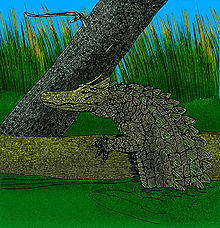- Ceratosuchus
-
Ceratosuchus
Temporal range: Latest Paleocene - earliest Eocene
Ceratosuchus burdoshi Scientific classification Kingdom: Animalia Phylum: Chordata Class: Sauropsida Order: Crocodilia Family: Alligatoridae Subfamily: Alligatorinae Genus: Ceratosuchus
Schmidt, 1938Species - C. burdoshi Schmidt, 1938 (type)
Ceratosuchus is an extinct genus of alligatorine from latest Paleocene rocks of Colorado's Piceance Basin and earliest Eocene rocks of Wyoming's Bighorn Basin in North America, a slice of time known as the Clarkforkian North American Land Mammal Age. Like its modern relatives, Ceratosuchus was a swamp-dwelling predator. It is named for the pair of flattened, triangular bony plates that extend from the back of its head. The type species is C. burdoshi.
Description
Ceratosuchus was named in 1938 by K. P. Schmidt for a skull from Colorado. Further remains, including skulls, mandibles, and cervical armor, was recovered from Wyoming by University of Michigan paleontologists and described by William Bartels in 1984. The skull, of a moderately-size alligatorine, is most notable for its horns, formed by expansion of the bones (squamosals) that formed the rear corners of the skull roof. These horns were bulbous and pointed up. There were five teeth in both of the bones that made up the tip of the snout (premaxilla), fifteen in the paired maxillae that formed the sides of the upper jaw, and twenty in both dentaries of the lower jaw. The front of the lower jaw had a flattened shape, and the teeth located here pointed partially forward, with a spade-like form. The teeth had variable shapes; the first thirteen teeth in the lower jaw were pointed, while the last seven graded from a spatulate shape to a large globular shape. Aside from the horns, the skull and particularly the lower jaw of Ceratosuchus were very similar to that of its contemporary Allognathosuchus. The neck armor had blade-like keels that may have been aligned with the skull horns.[1]
Paleobiology
Although Ceratosuchus is the only known horned alligatorine, horns are not unknown in crocodilians; similar structures are known for two species of Crocodylus, C. robustus and C. rhombifer. Bartels proposed that the horns' small size and bluntness made them unlikely weapons, and their small size also made use in a threat display unlikely. Instead, he favored their use as signals for species recognition: in this case, the horns would allow Ceratosuchus and species of Allognathosuchus to tell each other apart.[1]
Ceratosuchus is known from overbank mudstone deposits. It so far has been a rare find compared to Allognathosuchus from the same rocks. Bartels reported that only 5% of Clarkforkian crocodilians collected by the University of Michigan can be certainly assigned to Ceratosuchus (although this may be partially artificial because fragmentary specimens of Ceratosuchus could be confused with Allognathosuchus). Ceratosuchus may have been ecologically restricted in comparison to Allognathosuchus.[1]
Although the blunt posterior teeth of Allognathosuchus and Ceratosuchus have been traditionally interpreted as for feeding on mollusks or turtles, Bartels noted that these crocodilians were too small to feed on large bivalves or non-juvenile turtles, and that modern crocodilians usually swallow snails whole. Instead, he proposed that skull morphology and tooth wear better fit generalized predation on a variety of invertebrates and vertebrates.[1]
References
Categories:- Paleogene crocodylomorpha
- Paleocene reptiles
- Eocene reptiles
- Prehistoric reptiles of North America
Wikimedia Foundation. 2010.
